Menu:
About the Survey
Arab Public Opinion toward Normalization with Israel
Section 1: Living Conditions of Arab Citizens
Section 2: Perceptions of State Institutions and Governmental Effectiveness
Section 3: The Arab Public’s Attitudes toward Democracy
Section 4: Civic and Political Participation
Section 5: Religion and Religiosity in the Public Sphere and Political Life
Section 6: Arab Public Opinion and Intra-Arab Relations
Section 7: Arab Public Opinion toward ISIL
About the Survey
The 2019-2020 Arab Opinion Index is the seventh in a series of yearly public opinion surveys across the Arab world conducted by Arab Center for Research and Policy Studies in Doha, Qatar. The first was conducted in 2011, with surveys following in 2012-2013, 2014, 2015, 2016, and 2017-2018.
The 2019-2020 Arab Opinion Index is based on the findings of face-to-face interviews conducted with 28,288 individual respondents in 13 Arab countries: Algeria, Egypt, Iraq, Jordan, Kuwait, Lebanon, Mauritania, Morocco, Palestine, Qatar, Saudi Arabia, Sudan, and Tunisia. Sampling followed a randomized, stratified, multi-stage, self-weighted clustered approach, giving an overall margin of error between +/- 2 % and 3% for the individual country samples. The overall samples guarantee probability proportional to size (PPS), ensuring fairness in the representation of various population segments. With an aggregate sample size of 28,288 respondents, the Arab Opinion Index remains the largest public opinion survey in the Arab world. The fieldwork was carried out by an overall team of 900 individuals, equally balanced by gender, who conducted 69,000 hours of face-to-face interviews. The team covered a total of 820,000 kilometers (approximately 510,000 miles) across the population clusters sampled.
The sample size ranged between 1,500 and 2,500 respondents in each country and was 50% female and 50 % male in all countries, with 24% aged 18-24, 25% 25-34 years, 20% 35-44, 15% 45-54, and 15% 55 years and older. In terms of education levels, 16% were illiterate or had limited education, 34% had an education below secondary school, 23% had a secondary school education, and 26% achieved a level higher than secondary school.
The sections below give selected highlights of the findings of the 2019-2020 Arab Opinion Index. The results of the index are presented according to 1) the countries surveyed and 2) the general average of each Arab region. For the purposes of comparison, the data of the countries surveyed are sometimes classified according to the geographical regions of the Arab world, namely: Arab Maghreb (including Mauritania, Morocco, Algeria, and Tunisia), the Nile Valley (including Egypt and Sudan), the Arab Mashreq (including Palestine, Lebanon, Jordan, and Iraq), and the Gulf (including Saudi Arabia, Kuwait, and Qatar).
Section 1: Living Conditions of Arab Citizens
- Only 27% of respondents, mostly in the Gulf region, reported that their household income was sufficient for them to save beyond covering necessary expenditures. A further 43% reported that while their household income was sufficient to cover necessary expenditures, it was not enough to sustain savings. Further, fully 26 % of citizens in the Arab region live “in need,” in that their household incomes do not cover their necessary expenditures (see Figure 1). As expected, the comfortable families are concentrated in the Gulf region, while families in need are centered in the Mashreq.

- 69% of respondents evaluate the level of safety/security in their home countries positively, while 30% view it negatively. 46% of respondents evaluate their home countries’ economic situations positively, compared to 52% who have an overall negative view (see Figure 2). The majority of respondents in Arab countries, with the exception of those in the Gulf, evaluated the economic situation in their countries negatively, especially in the countries of the Arab Mashreq (Figure 4). By comparison, 48% view their home countries’ political situations positively, while 47% have a negative view (Figure 3). Most respondents in the Gulf states evaluated the political situation as positive (Figure 5). In an aggregate sense, respondents’ evaluation of the political situation in their countries was the most positive in the 2019/2020 poll, compared to all previous annual polls of the Arab Opinion Index since 2011.




- When asked to identify the most pressing problems for their countries to tackle, 57% of respondents provided answers that focused on economic issues: unemployment, poverty, and inflation. A further 10% offered answers that centered on safety, security, and political stability while 16% gave answers concerning political issues, such as governance, democratic transition, insufficient public services, and financial and administrative corruption.
- As Figure 6 shows, 22% of Arabs want to immigrate to other countries. Older respondents were less interested in immigration; 10% of those ages 55 and over wished to immigrate compared to 15% among the age group 45-54, 19% among those 35-44 years old, 29% for ages 25-34, and 33% among respondents aged 18-24 years. While a desire for economic improvement was the most cited incentive to leave one’s country, 15% of would-be emigrants were motivated by education or continuing education and 12% cited political reasons and concerns over safety and security. This was highly dependent on the subjective circumstances in the country surveyed; more than a quarter of respondents in the Mashreq, Maghreb, and Nile Valley countries want to immigrate, compared to 5% in the Gulf countries.

Section 2: Perceptions of State Institutions and Governmental Effectiveness
- Results from the 2019-2020 Arab Opinion Index reflect a generally low level of public confidence in Arab governments and civilian government institutions (judicial, executive, and legislative branches). People showed the least confidence in representative legislative councils. In contrast, the Arab public generally has a high level of confidence in the military and public security institutions. See Figure 7 below.

- Arab public opinion is polarized when evaluating the performance of legislative councils in Arab countries with regard to their oversight of governments or their representation of social groups and sects: Half of the respondents believe that these councils fulfill their role at these levels, while about half believe that they do not. It is important to note that there is variation on this issue by country, and that respondents in Tunisia and Kuwait boosted the overall positive ratings for such councils.
- In general, the Arab public views the performance of their governments negatively (50%) when asked about foreign policies, economic policies, and a range of public policies and services, compared to 43% who evaluated government performance as positive. These findings are consistent with the public’s evaluation of government performance in previous annual polls of the Arab Opinion Index.
- There is a clear consensus among the Arab public that corruption is widespread across their countries: 91% believe that corruption exists in their home countries, compared to only 7% who believe that corruption is not present at all (see Figure 8). The data also show that citizen perceptions of the extent of corruption in their countries have not changed substantially over the course of the seven polls (since 2011). Respondents in the Mashreq countries are most certain of the spread of corruption in their countries, while the highest rates were recorded in the Gulf countries that corruption was not widespread. There is a prevailing belief that corruption is widespread in both the public and private sectors, albeit in greater proportions in the public sector. 43% of the respondents believe that politicians contribute most to the spread of financial and administrative corruption, followed by businessmen at 23%, then senior state employees (16%).

- As seen in Figure 9, only 32% of the Arab public believes that the rule of law is applied equally among citizens, while 46% maintain that the rule of law is applied in their home states but that some groups are shown favorable treatment, and 20% expressed the opinion that the rule of law is not applied equally in their home countries at all.
- Further, 35% of the Arab public believes that the principle of a fair trial is not upheld in their home countries while 62% said it was applied (Figure 10).


Section 3: The Arab Public’s Attitudes toward Democracy
- Of the overall group of respondents, an average of 39% defined democracy as safeguarding citizens’ political and civil liberties; 20% viewed it as the guarantee of equality and justice for citizens; 14% affirmed participation and the institutional aspect of a democratic system (circulation of power, separation and control between the authorities); 9% saw it as the protection of safety or security; and 7% cited the improvement of economic conditions. The results show an increase in the percentage of those who defined democracy as participation and the institution of democratic governance, especially in countries such as Egypt, Jordan, and Mauritania.
- As shown in Figure 11, a full 74% of Arabs believe that democracy is the most appropriate system of governance for their home countries; this is when they were asked to compare democracy to other systems (such as authoritarian regimes, representative democracies where electoral competition is limited to either Islamist or non-Islamist/secular political parties, or theocracies). Additionally, a majority of Arabs surveyed disagrees with a set of widespread statements that are often employed in public discourse to discredit democracy (e.g., “Democracy is incompatible with Islam”), but they are divided on the statement that their society is not prepared to practice the democratic system (see Figure 12).


- A slight majority of Arab citizens, or 51%, said they would accept an electoral victory that resulted in a rise to power of a political party with which they disagreed, while 43% stated that they would be opposed to the ascendancy of a political party with which they disagreed.
- This consensus on support for democracy is accompanied by a negative evaluation of existing democracy in the Arab world. On average, respondents placed the level of democracy in the region at 5.8 on a scale from 1 to 10 (see Figure 13).
- When asked if citizens in their home countries were free to criticize their government without fear of retribution, 30% of the Arab public said this was impossible to do. Arab citizens’ evaluations of their ability to criticize the governments of their countries on a scale of 1 to 10 also showed limited ability to criticize their own governments; this criterion received an average score of 6.0 out of 10 (see Figure 13). Tunisia, Sudan, and Mauritania got the highest scores, while Palestine and Saudi Arabia scored the lowest in this regard. Respondents’ ability to criticize the governments of their countries was the highest in the Arab Maghreb region, and the lowest in the Gulf region.
- It is important to note here that Palestinian respondents were asked about the “Palestinian government,” which means that respondents in Gaza answered with the Hamas government in mind and respondents in the West Bank answered about the Palestinian Authority. However, when defining democracy, Palestinian respondents referred to the conditions related to the Israeli occupation and its policies.

- In assessing the views of citizens on the 2011 Arab uprisings at the time of their occurrence, results showed that 58% still consider the uprisings to have been positive, and 28% consider them to have been negative. This percentage of those whose assessment is positive is the highest in the 2019-2020 poll since this question was included in the survey in 2012/2013 (see Figure 14). In terms of region, the positive responses from countries in the Nile Valley (Egypt and Sudan) were the highest, at 75% (Figure 15).


- When asked about the reasons that prompted people in 2011 to participate in the Arab revolutions and protest movements, 35% of the respondents cited ending oppression and dictatorship and supporting democracy, political freedoms, and justice and equality. 31% cited corruption and 16% poor economic conditions as the reasons for the Arab Spring.
- The Arab public is divided in terms of its outlook toward the future path of the Arab Spring. 48% maintain that the revolutions are in a faltering phase but will ultimately achieve their aims. In contrast, 30% of Arabs believe that the Arab Spring has been aborted before the revolutions could achieve their aims, and that the former regimes have returned to power (Figure 16).

- Public opinion in the Arab region in support of the Sudanese and Algerian revolutions varies greatly among countries, with the least support in the Gulf countries. It is noteworthy that, on average, non-responses for this question represent a third of the answers (see Figures 17 and 18).


- As seen in Figure 19, the majority of the respondents whose countries witnessed popular protests supported these protests: 82% of Iraqis support the popular protests in Iraq, 81% of the Sudanese supported the popular protests in Sudan, 71% of Algerians support the popular protests in Algeria, and 67% of the Lebanese people support the protests in Lebanon. However, participation rates in the popular protests ranged from 15% to 37% in Algeria, Lebanon, Iraq, and Sudan.

Section 4: Civic and Political Participation
- Despite the fact that citizens in the Arab world support democracy, their political and civic participation is limited. The results show a trend toward increased political apathy: at present, the percentage of those who said they do not want to participate in elections has risen to 46%, up from 27% in the surveys of 2011 to 2013. Moreover, 28% said that they are “completely unconcerned” about political affairs in their countries (Figure 20).

- Membership and participation in civil society and voluntary organizations remain extremely limited across the Arab region, with no more than 16% of respondents reporting that they are members of such groups in any given country. When taking into account the level of active participation in the activities of such groups, the level of effective participation would likely diminish further still.
- Additionally, only 11% of Arabs report being members in a political party, 17% are non-members who feel their views are represented by existing groups, while 61% have no affiliation with a political party nor do they feel that their views are represented by any existing political group or bloc, and 11% did not know or declined to answer (see Figure 21).

- Most citizens (48%) still rely on television channels for political news coverage, followed by internet (35%) and radio (6%). Since many sources on the internet are news channels and newspaper sites, the change here is more in the means of accessing news than in the type of broadcasting or publishing institution (see Figure 22).
- Regarding the 35% of Arabs who follow the news on the internet (including social media sites belonging to satellite channels), there were some noteworthy correlations: respondents from countries that have high rates of political apathy and no room for criticism are the ones who follow political news the least (e.g., those living in Saudi Arabia and Egypt); in contrast, people living in countries with more open political systems are more concerned with following political news.
- Fundamental changes have appeared over the past nine years in the sources for political news, with an increase in use of the internet over television. 35% of respondents stated they rely on the internet for political news, the highest proportion since 2011 and one that represents a sevenfold increase over this period, with reliance on television channels decreasing.

- While 73% of respondents reported using the internet, to varying extents, only 26% indicated that they never use the internet. The results from the 2019-2020 poll show a continuing, statistically significant increase in internet penetration in the Arab region (Figures 23 and 24).


- The vast majority of Arabs who use the internet also have accounts on Facebook, at 85%, while 84% have accounts on WhatsApp, 45% on Twitter, 55% on Instagram, and 44% on Snapchat (see Figure 25). The Gulf region was an exception for Twitter, where 87% of respondents report having a Twitter account. The most used language while browsing the internet was, predictably, Arabic (at 87%), with English and French the second languages most used.

- 80% of social media users in the Arab region use social media to obtain news and political information, with 20% using it more than once daily. In terms of engagement, 61% use social media to express their views on political events, with 28% daily use or multiple times a day. A similar 61% of social media account holders use such media to interact with political issues, 47% of whom use them daily or multiple times a day. The society that least uses social media to interact with political issues was Saudi Arabia. This has been reflected in the Gulf region as a whole.
Section 5: Religion and Religiosity in the Public Sphere and Political Life
- Based on self-reporting, a majority of the Arab public is “Religious, to some extent” (63%). This compares with 12% of the Arab public who define themselves as “Not religious” and 23% as “Very religious” (see Figure 26).

- When asked to define the attributes that define religiosity, just over half of the respondents provided answers that focused on an individual’s morality and values (51%) rather than the observance of religious practices (39%). This value has not changed significantly since 2011.
- While most Arabs describe themselves as somewhat religious, the majority opposes edicts that pass negative judgments against members of other religions, or which declare followers of differing interpretations of Islam to be apostates. They also disagree that non-religious people are inherently bad people. A majority (65%) agrees that no religious authority is entitled to declare followers of other religions infidels (Figure 27).

- When conducting social, political, and economic/business interactions, most respondents (62%) show no preference between dealing with religious and non-religious individuals, while 30% said that they prefer dealing with religious people (see Figure 28). This represents a significant change since 2011, as the percentage of people who profess no preference decreased from 70% in 2011 to 62% today.
- Most Arabs (71%) oppose the employment of religion by governments in order to win support for their policies. At the same time, Arab public opinion is split almost in half in attitudes toward the general separation of religion from the state, with a slightly greater inclination toward supporting the principle of separation of religion from political life (49%), compared to 44% of respondents who oppose this view (Figure 29).


Section 6: Arab Public Opinion and Intra-Arab Relations
- A total of 81% of the respondents to the 2019-2020 Arab Opinion Index supported the sentiment that the various Arab peoples constitute a single nation, in contrast to 16% who agreed with the statement that “the Arab peoples are distinct nations, tied together by only tenuous bonds.”
- As seen in Figure 30, Arab public attitudes regarding the foreign policies of regional and global powers toward the Arab region are broadly negative. 58% of respondents held negative views of US policy toward the Arab countries; 58% also had negative views of Iran’s Arab policies; and 41% expressed negative views of Russia’s policy toward the Arab states. The Arab public’s most negative foreign policy evaluation in the 2019-2020 poll is of the US, Russian, Iranian, and French foreign policies, while Arab public opinion regarding German, Chinese, and Turkish foreign policy received more positive evaluation than other international and regional powers.

- When asked to look at specific US foreign policy areas, vast majorities of Arabs had negative views of US policy toward Palestine (81%), Syria (77%), Yemen (74%), and Libya (70%). See Figure 31.
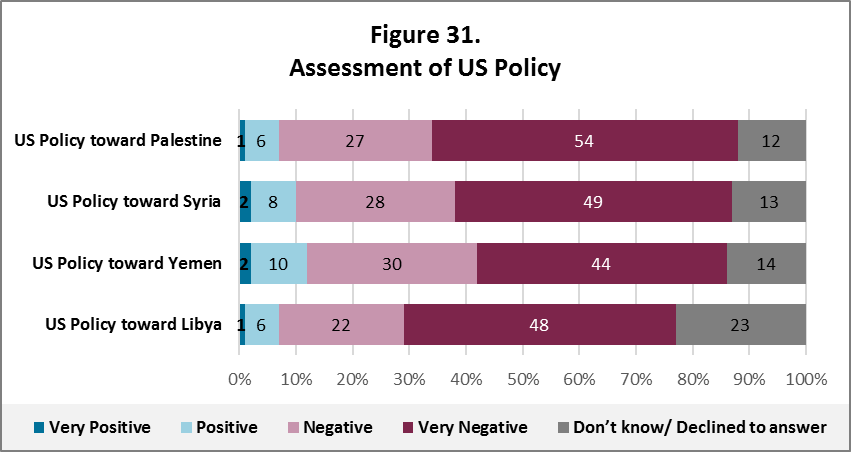
- When asked to look at specific Russian foreign policy areas, the majority of Arab respondents had negative views of Russian policy toward Palestine (59%), Syria (60%), and Yemen (60%), while 47% viewed Russian policy toward Libya negatively. Arabs also assess Iranian foreign policy in the region negatively: over half of the respondents have negative views of Iranian policy toward Palestine (58%), Syria (60%), and Yemen (61%). 54% of Arab respondents view French policy toward Libya negatively. They also have a negative view of French policy toward Palestine (53%), Syria (53%), and Yemen (51%). In contrast, the Arab public is roughly equally split in its perceptions of Turkish foreign policy in Libya: 31% views it positively, compared to 42% who view it negatively (it is worth noting that 27% declined to answer this question). Similarly, 42% of the respondents had positive views of Turkey’s policies toward Palestine, compared to 41% who had negative views of Ankara’s policies.
- Respondents in the Arab region provided different answers when asked (in an open-ended question format) to name the country that poses the largest threat to their national security. 66% of the Arab public considers Israel and the United States (a combined total) as the two countries that most threaten the security of the Arab world, while Iran comes in third place with 12% (Figure 32). The respondents of the Arab Maghreb were highest in their assessment of Israel as the country most threatening to the security of the Arab world, while respondents in the Arab Mashreq were the highest in assessing the United States as the greatest security threat.
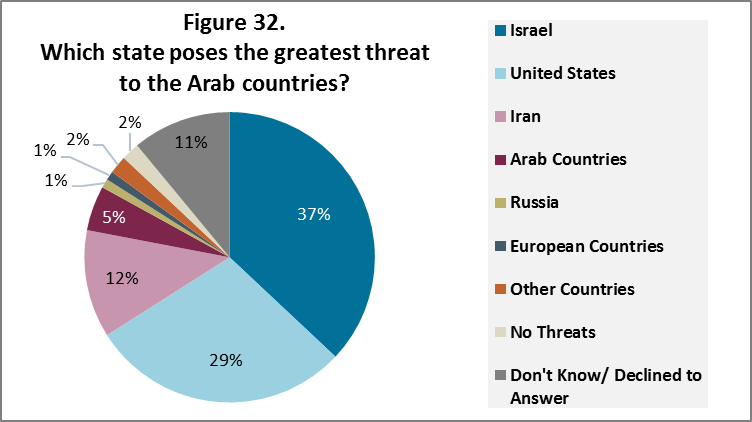
- Overall, when presented with a list of countries and asked if each country poses a threat to the security and stability of the region, 89% of Arabs believe that Israel poses a threat, 81% believe that the United States poses a threat, 67% of the respondents expressed their belief that Iranian policies threaten the security and stability of the region, while this percentage was 55% with regard to Russian policies and 44% with regard to French policies. See Figure 33.

- As shown in Figure 34, over three-quarters of the population of the Arab world agrees that the Palestinian cause concerns all Arabs, and not the Palestinians alone. It should be noted that 89% of Saudis agreed that the Palestinian issue is one of concern to all Arabs and not simply only to the Palestinians themselves. Gulf public opinion had the highest percentage of respondents considering the Palestinian cause to be an issue for all Arabs, followed by the Arab Maghreb’s public opinion.
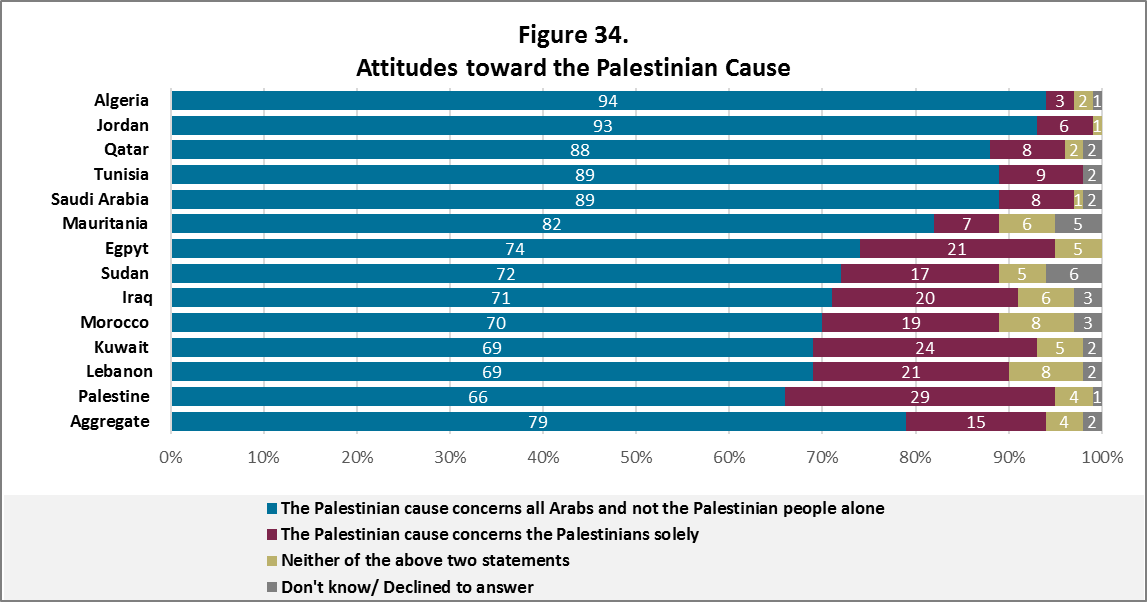
- An overwhelming majority (88%) of Arabs would disapprove of recognition of Israel by their home countries, with only 6% accepting formal diplomatic recognition (see Figure 35). When asked to elaborate on the reasons for their positions (Figure 36), respondents who were opposed to diplomatic ties between their countries and Israel cited Israel’s colonial and expansionist policies as well as its racism toward the Palestinians and persistence in expropriating Palestinian land. In addition, one-half of those who accepted recognition of Israel by their governments made such recognition conditional on the establishment of an independent Palestinian state.
- When looking at Arab public opinion regarding this issue by country (Figure 35), the highest rate of refusal to recognize Israel was among respondents in Algeria at 99%, followed by those in Lebanon at 94%, and Tunisia and Jordan at 93% each. In the Gulf region; 88% of respondents in Qatar and Kuwait reject the idea of their countries recognizing Israel, while in Saudi Arabia, 65% expressed their rejection as contrasted with 6% who agreed to recognition and 29% refused to express their opinion. Only 13% of the Sudanese agreed that their country should recognize Israel, compared to 79% of them who rejected such a step. When examining the different age groups, there were no differences in refusal to recognize Israel: among all age groups, between 87% and 90% opposed diplomatic recognition of Israel by their country.
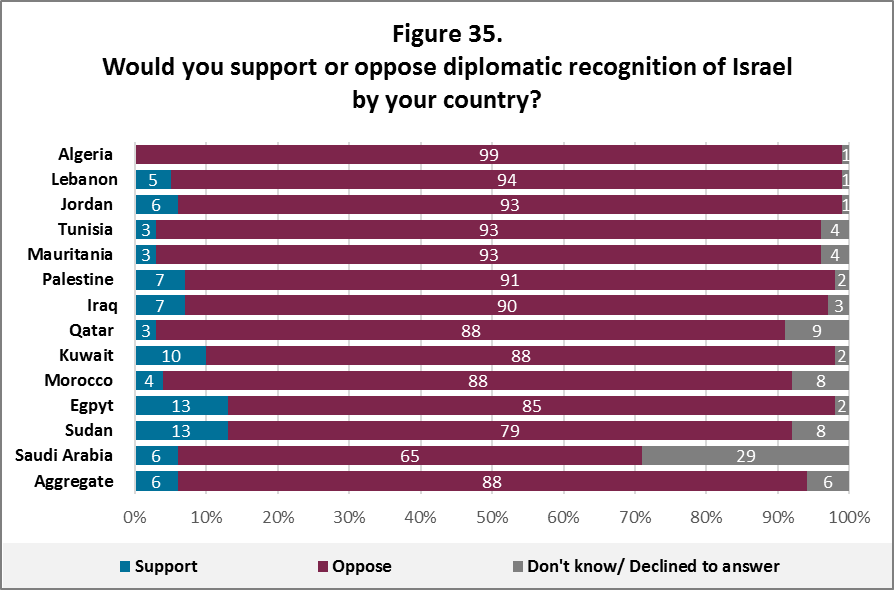
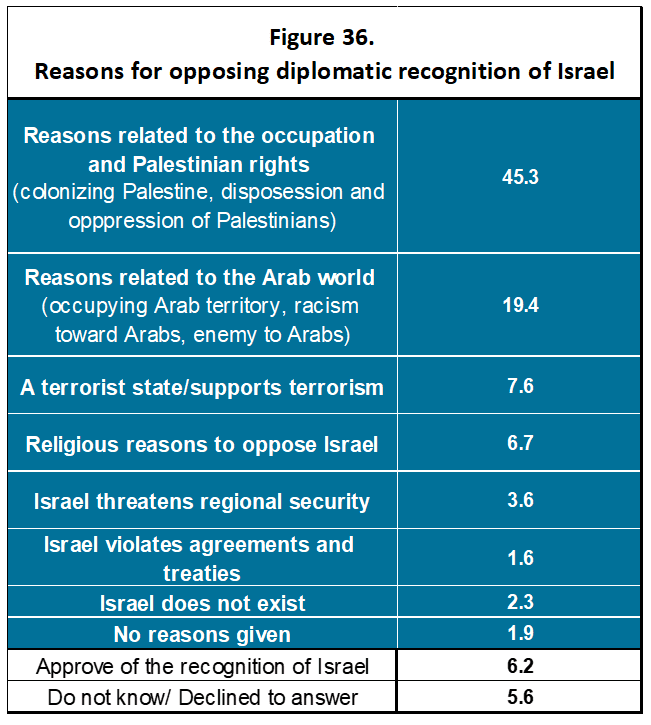
Section 7: Arab Public Opinion toward ISIL
- An overwhelming majority (88%) of the Arab public has a negative view of ISIL (Islamic State of Iraq and the Levant), with only 3% expressing a “very positive” view and 2% “positive to some extent” (see Figure 37).
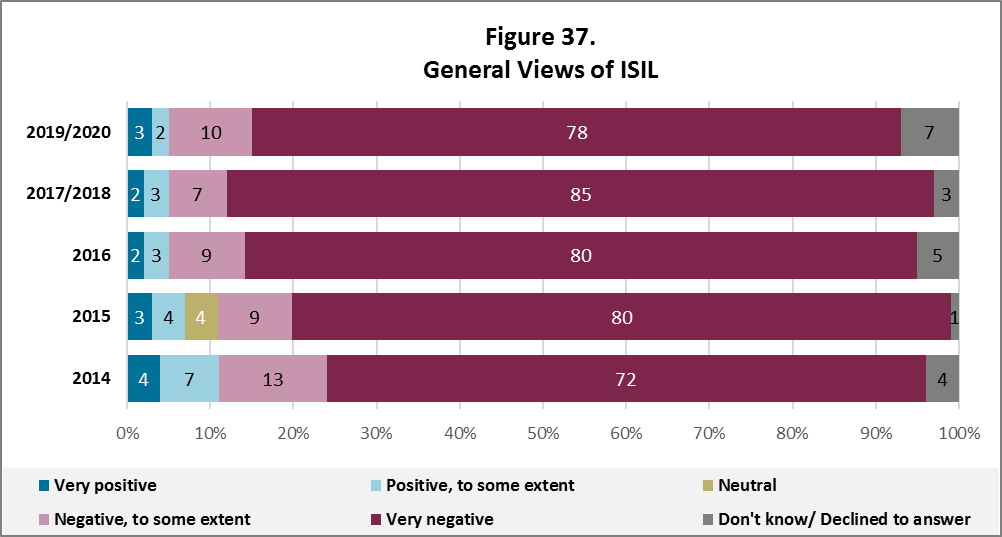
- When asked if the existence of ISIL was the result of internal factors endemic to the region or the result of foreign activity, 27% of respondents expressed the view that the group’s existence resulted from the internal conflicts extant in the Middle East, compared to 55% who attributed ISIL’s existence to the policies of foreign powers. When presented with another two statements regarding the origins of ISIL, 42% of respondents were prepared to attribute the rise of ISIL to the extremism inherent in Middle Eastern societies while 33% attributed the rise of ISIL to the policies of Arab regimes. These findings can be seen in Figure 38.
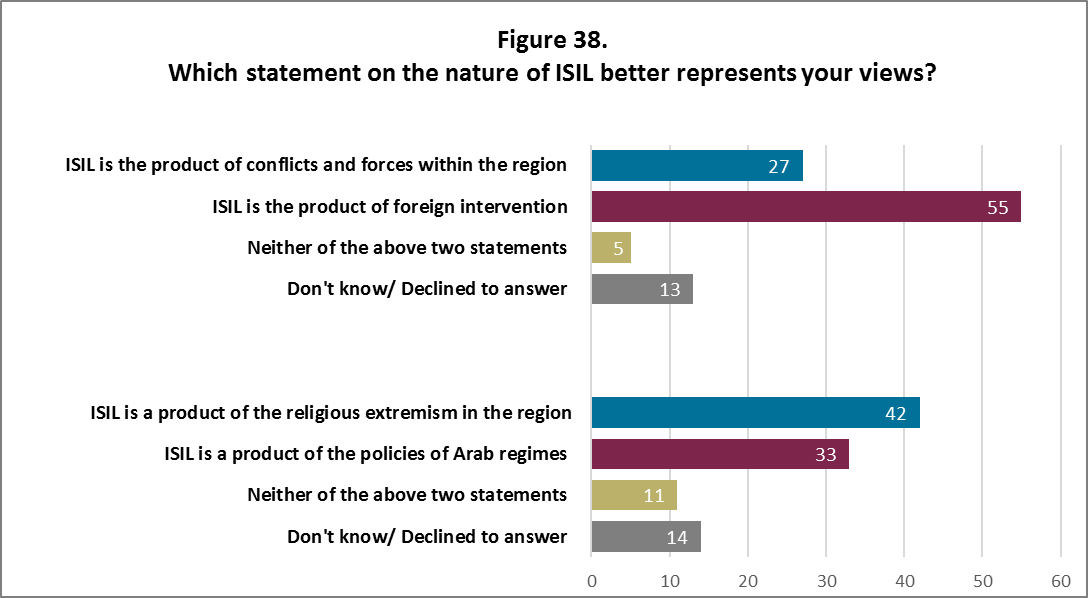
- The Arab public offers a diverse set of remedies when asked to suggest the best means by which to combat ISIL. The three most common preferences for tackling ISIL, and terrorist groups more broadly, were resolving the Palestinian cause (the most widely selected first choice at 17%); ending foreign intervention in Arab countries (selected as a first choice by 15% of respondents); and using direct military action (13%).
